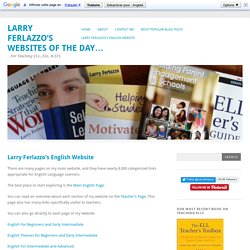

Great website for language teachers - Teacher Training Videos. Develop students speaking skills - Teacher Training Videos. Great website for language teachers - Teacher Training Videos. Learn Languages with Music Videos, Lyrics and Karaoke! Apprenez l'anglais avec des extraits de films et des jeux. ESL WebQuests. Larry Ferlazzo’s English Website. There are many pages on my main website, and they have nearly 8,000 categorized links appropriate for English Language Learners.

The best place to start exploring is the Main English Page. You can read an overview about each section of my website on the Teacher’s Page. This page also has many links specifically useful to teachers. Richard rothstein. Next February, this blog will be celebrating its ten-year anniversary!

Leading up to it, I’m re-starting a series I tried to do in the past called “A Look Back.” Each week, I’ll be re-posting a few of my favorite posts from the past ten years. I first began publishing “Best” lists in at the end of 2007 and the beginning of 2008 (there are now 1,600 of them!). Here are the sites I identified as the best in their respective categories for that year, along with my original commentary. Surprisingly, they are still online. Best Web 2.0 Application For Education:
ESOL Courses - Free English Lessons Online. EFL Magazine - The Magazine for English Language Teachers. Free Online Technology ICT Lessons. Power Up: Flipping Your Classes. NILE and Teacher Training Videos are teaming up again to run the popular PowerUp: Flipping Your Classes course.

This is a very popular course with many of the courses in 2018 being completely sold out. In 2016 the course was shortlisted for the British Council ELTons award. Watch this video and find out about the key principles behind the course and why it has provded so popular. Key Principles Behind the 'Flip your Class' course 'This course blew me away, it was more than I expected on several levels and it really got me charged up to plow ahead with flipping.
Robert Ransley The Anglo House Academy Los Santos de Maimona, Spain. 50 Essential Resources for ESL Students. Learning a new language is always daunting, especially when that language is as full of weird rules and contradictions as English.

Even native speakers sometimes have trouble mastering the nuances of tense and grammar. Fortunately, if English is not your first language, there are a variety of ESL resources online to help you master the English language. From speaking to writing, these tools will help you get a handle on English and give direction to your education and career. Don’t let the size of the task deter you from getting it done. The Seven Best Short Animated Films for the Language Classroom - Kieran Donaghy First film can be seen by clicking on link.
Animated films are ones in which individual drawings, paintings, or illustrations are photographed frame by frame.

Traditionally animated films have been associated with children, however, nowadays they are designed to appeal to everyone. With the increased ease of creating animations, there has been a huge rise in the number of animated films being produced, and the vast majority of these are short animations. Many of these short animated films can be exploited in the language classroom as they are short enough to be used in a single session, offer a complete narrative in a short space of time, have a unique capacity of grabbing and holding students’ attention, and deal with contemporary subjects and issues, such as bullying, racism, sexism, homelessness, and human rights, which are relevant to students’ lives.
Here are my seven favourite animated short films for the language classroom. Paperman Paperman is an Oscar-nominated short film by John Kahrs which went viral. Head Over Heels. Fluentu. A picture is worth a thousand words.

Nowhere is this truer than in the ESL classroom. Suppose after a verb game or during some reading comprehension exercise, one of your curious students wants to know the difference between “He danced at the party” and “He was dancing at the party.” What will you do? You could probably give a really clear explanation about how one sentence states what happened at a specific place or time, and the other gives background information to establish a scene in the past.
And then maybe you’d give a couple more examples prior to showing how the two very similar tenses—past perfect and past perfect continuous—do in fact differ. Or, you could draw a picture of two timelines, one representing each sentence, and have the students describe them. Which would be more effective? The Benefits of Using Visual Aids in the ESL Classroom Visual aids, like those two timelines, are so perfect for the ESL classroom. Helps students understand and remember concepts more easily. Larry Ferlazzo: What Does Enhanced Discovery Learning Look Like In The ELL Classroom? Increasing Student Engagement and Retention Using Online Learning Activities ... - Google Books. 5 super cool short films your ELA students will love – Literature Daydreams. I love using short films in my classroom.

I bet you already have a collection that you use again and again. Well, me too. I use short films for a bunch of different reasons: to introduce a new idea, or explain something we all found complicated. Sometimes to inspire discussion and debate, or to get stuck into some creative writing. Short films are fabulous for both literature and writing. Can Do Booklet 9 12. Can Do Booklet 6 8. Can Do Booklet 3 5. Can Do Booklet Grades 1 2 ESL. Can Do Booklet PreK. CAN DO Descriptors by grade level cluster; download for PreK-K, Grades 1-2, 3-5, 6-8, or 9-12. Look at all we can do!

Creating learning environments for language learners based on what they can do! The Can Do Descriptors highlight what language learners can do at various stages of language development as they engage in teaching and learning in academic contexts. WIDA is proud to announce the release of the K–12 Can Do Descriptors, Key Uses Edition, the Early Years Can Do Descriptors (for children 2.5–5.5 years old), and the K–12 PODEMOS, the Spanish Language Development Edition of the Can Do Descriptors. The links below will take you directly to their pages.
Note of Thanks The development of the Can Do Descriptors represents the work of many educators in the field. 12 Ways to Support English Learners in the Mainstream Classroom. To Boost Higher-Order Thinking, Try Curation.